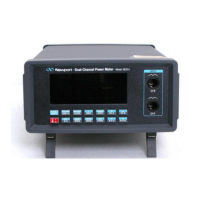RANGE-n
Signal Range Select
Syntax:
RANGE-n <ranges
where n is either
A
or
B
Parameters:
The parameter <range>
is
of type <number>. The range of this parameter will
depend on the detector and mode being used to acquire data.
See
the section
entitled "Electrical Specifications" at the beginning of this manual for the
signal range that corresponds to the current setting of
<range>.
Function:
This command
is
used to select a new manual signal range. This command
will disable the auto ranging feature.
Related Commands:
AUTO-n, AUTO-n?, RANGE-n?
RANGE-n?
Signal Range Query
Syntax:
RANGE-n?
where
n
is
either
A
or
B
Parameters:
None
Function:
This query returns a value that represents the current signal range setting
being used whether the meter
is
auto ranging or in manual ranging mode.
See
Section
2.3.1
1.
Returns:
<range>
<range>
is
of type <number> and represents the gain level currently being
used for either auto or manual ranging. See the section entitled "Electrical
Specifications" at the beginning of this manual for the signal range that
corresponds to
<range>.
Related Commands:
AUTO-n, AUTO-n?, RANGE-n
-EL-n
Reference Source Select
Syntax:
REFSEL-n <sources
Parameters:
<source> is of type <string> in the double quote format. The possible values
of <source> are: "STOREF'
-
Last stored reference measurement, "OTHERCH"
-
The other channel, "USRREF'
-
User defined reference value
Function:
This command
is
used to select a reference source to be used in linear and
logarithmic (dB) relative measurements. This command will cause an error
if
an
attempt
is
made to select the other channel as a reference
if
it
is
not
available.
Returns:
None
Related Commands:
REFSEL-n?, STOREF-n, USRREF-n, USRREF-n?
Artisan Technology Group - Quality Instrumentation ... Guaranteed | (888) 88-SOURCE | www.artisantg.com

